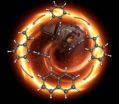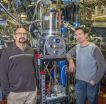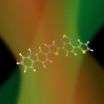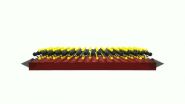(Press-News.org) Researchers at the Department of Energy's Lawrence Berkeley National Lab (Berkeley Lab) and the University of Hawaii have uncovered the first step in the process that transforms gas-phase molecules into solid particles like soot and other carbon-based compounds.
The finding could help combustion chemists make more-efficient, less-polluting fuels and help materials scientists fine-tune their carbon nanotubes and graphene sheets for faster, smaller electronics. In addition, the results could have implications for the burgeoning field of astrochemistry, potentially establishing the chemical process for how gaseous outflows from stars turn into carbon-based matter in space.
"When you burn a flame, you start with a gas-phase reactant and then analyze the products, which include soot," says Musahid Ahmed, scientist in the Chemical Sciences Division at Berkeley Lab. "But there is no direct evidence for the chemical bonds that break and form in the process." For more than 30 years, scientists have developed computational models of combustion to explain how gas molecules form soot, but now Ahmed and his colleagues have data to confirm one long-standing theory in particular. "Our paper presents the first direct observation of this process," he says.
While the research is relevant to a number of disciplines—combustion science, materials science, and astrochemistry—it's combustion science that could see the most direct impact the soonest, says Ahmed. Specifically, the fundamental chemistry discovery could be used to find or design fuels that burn cleaner and don't produce as much soot.
Think about your car engine. If the combustion process were perfect, only carbon dioxide and water would come out of the tailpipe. Instead, we see fumes and particulates like soot, a visible macromolecule made up of sheets of carbon.
Theoretically, there are hundreds of different ways molecules can combine to create these dirty emissions. But there has been one popular class of mechanisms that outlines possible early steps for bond making and bond breaking during combustion. Called hydrogen abstraction-acetylene addition, or HACA, it was developed by Michael Frenklach professor of mechanical engineering at the University of California Berkeley in 1991.
One version of HACA works like this: during the high-temperature, high pressure environment of combustion, a simple ring of six carbon and six hydrogen atoms, called benzene, would lose one of its hydrogen atoms, allowing another two-carbon molecule called acetylene, to attach to the ring, giving it a kind of tail. Then the acetylene tail would lose one of its hydrogen atoms so another acetylene could link up in, doubling the carbon atoms in the tail to four.
Next, the tail would curl around and attach to the original ring, creating a double-ring structure called naphthalene. Link by link, ring by ring, these molecules would continue to grow in an unwieldy, crumpled way until they became the macromolecules that we recognize as soot.
To test the first step of the theoretical HACA mechanism, Ahmed and collaborators from the University of Hawaii used a beamline at the Advanced Light Source (ALS) at Berkeley Lab specifically outfitted to study chemical dynamics. The ALS, a DOE Office of Science user facility, produces numerous photons over a wide range of energies, allowing researchers to probe a variety of molecules produced in this chemical reaction with specialized mass spectrometry analysis.
Unique to this experimental setup, Ahmed's team used a so-called hot nozzle, which recreates combustion environment in terms of pressure and temperature. The group started with a gaseous mix of nitrosobenzene (a benzene ring with a molecule of nitrogen and oxygen attached) and acetylene, and pumped it through a heated tube at a pressure of about 300 torr and a temperature of about 750 degrees Celsius. The molecules that came out the other end were immediately skimmed into a mass spectrometer that made use of the synchrotron light for analysis.
The researchers found two molecules predominantly emerged from the process. The more abundant kind was the carbon ring with a short acetylene tail on it, called phenylacetylene. But they also saw evidence for the double ring, naphthalene. These results, says Ahmed, effectively rule out one HACA mechanism—that a carbon ring would gain two separate tails and those tails would bond to form the double ring—and confirm the most popular mechanism where a long tail curls around to form naphthalene.
Ahmed's local team included Tyler Troy, postdoctoral fellow at Berkeley Lab, and this work was performed with long-term collaborator Ralf Kaiser, professor of physical chemistry at the University of Hawaii at Manoa, and Dorian Parker, postdoctoral fellow also at Hawaii. The research was published June 20 online in the journal Angewandte Chemie.
"Having established the route to naphthalene, the simplest polycyclic aromatic hydrocarbon, the next step will be to unravel the pathways to more complex systems," says Kaiser.
Further experiments will investigate these follow-up mechanisms. It's a tricky feat, explains Ahmed, because the molecular possibilities quickly multiply. The researchers will add infrared spectroscopy to their analysis in order to catch the variety of molecules that form during these next phases of combustion.
INFORMATION:
This research was funded by the DOE Office of Science and the National Science Foundation.
Lawrence Berkeley National Laboratory addresses the world's most urgent scientific challenges by advancing sustainable energy, protecting human health, creating new materials, and revealing the origin and fate of the universe. Founded in 1931, Berkeley Lab's scientific expertise has been recognized with 13 Nobel prizes. The University of California manages Berkeley Lab for the U.S. Department of Energy's Office of Science. For more, visit http://www.lbl.gov.
The DOE Office of Science is the single largest supporter of basic research in the physical sciences in the United States and is working to address some of the most pressing challenges of our time. For more information, please visit science.energy.gov.
The chemical dynamics beamline can be viewed on the web at chemicaldynamics.lbl.gov, snapshots of Ahmed's science are available at https://sites.google.com/site/musaswebcorner/home and Prof. Kaiser's homepage is here - http://www.chem.hawaii.edu/Bil301/
Up in flames: Evidence confirms combustion theory
Berkeley Lab and University of Hawaii research outlines the story of soot, with implications for cleaner-burning fuels
2014-07-01
ELSE PRESS RELEASES FROM THIS DATE:
Study finds online bullying creates off-line fear at school
2014-07-01
HUNTSVILLE, TX (7/1/14) -- Cyberbullying creates fear among students about being victimized at school, a recent study by Sam Houston State University found.
While traditional bullying still creates the most fear among students, cyberbullying is a significant factor for fear of victimization at school among students who have experienced bullying or disorder At school, such as the presence of gangs. The fear from cyberbullying is most prominent in minority populations.
"It cannot be overstated – online victimization has offline consequences, and those consequences may ...
Scientists discover how plastic solar panels work
2014-07-01
This news release is available in French.
Scientists don't fully understand how 'plastic' solar panels work, which complicates the improvement of their cost efficiency, thereby blocking the wider use of the technology. However, researchers at the University of Montreal, the Science and Technology Facilities Council, Imperial College London and the University of Cyprus have determined how light beams excite the chemicals in solar panels, enabling them to produce charge. "Our findings are of key importance for a fundamental mechanistic understanding, with molecular ...
Stanford engineers envision an electronic switch just 3 atoms thick
2014-07-01
VIDEO:
This animation shows the three-atom thick crystal being pulled from a non-conductive to conductive state, and then being pushed back to the non-conductive state.
Click here for more information.
Do not fold, spindle or mutilate. Those instructions were once printed on punch cards that fed data to mainframe computers. Today's smart phones process more data, but they still weren't built for being shoved into back pockets.
In the quest to build gadgets that can survive such ...
Updated guidelines covering fusion procedures for degenerative disease of the lumbar spine
2014-07-01
Charlottesville, VA (July 1, 2014). Experts in the spine surgery community—neurosurgeons and orthopedic surgeons—banded together to evaluate the recent literature on lumbar spine fusion procedures and to publish up-to-date evidence-based recommendations on their use. The Journal of Neurosurgery: Spine is pleased to announce today's publication of the American Association of Neurological Surgeons/Congress of Neurological Surgeons Joint Section on Disorders of the Spine and Peripheral Nerves' updated guidelines for the performance of fusion procedures for degenerative disease ...
Freeze-storage egg banking for egg donation treatment
2014-07-01
Munich, 1 July 2014: The rapid freezing technique of vitrification is set to revolutionise egg donation as a fertility treatment by enabling freeze-storage egg-banking. The cryopreservation of eggs was one of IVF's continuing challenges until the widespread introduction of vitrification; the older slow freezing methods induced the formation of ice crystals, which could cause damage to several structures of the egg. Thus, as demand for egg donation increases as a treatment for age-related infertility, egg banking with vitrification can theoretically provide a large pool ...
Preconceptional factors in the prediction of fertility and the reproductive lifespan
2014-07-01
Munich, 1 July 2014: A project in Denmark whose aim is to assess the reliability of preconceptional lifestyle and biological factors as predictors of fertility has found a pronounced effect of the contraceptive pill on markers used to assess "ovarian reserve", a predictor of future reproductive lifespan. Available evidence of whether the Pill has an effect on fertility has so far been reassuring - and usual advice to those stopping the Pill is that cycles will soon revert to normal, with pregnancy likely within six months or so.(1)
However, one continuing concern ...
Pregnancies following egg donation associated with more than 3-fold higher risk of hypertension
2014-07-01
Munich, 1 July 2014: With an ever-ageing female patient population, egg donation is an increasingly common treatment in infertility. ESHRE's own annual reports on fertility treatments in Europe show a rise in egg donation cycles from 15,028 in 2007 to 24,517 in 2010 (to 4.05% of all treatments). This proportion is still some way behind the USA, where egg donation now accounts for around 12% of all treatments.
As women age their store of viable eggs reduces such that their "ovarian reserve" (and likelihood of pregnancy) declines. Once the eggs have gone, they cannot be ...
Most women are aware of oocyte freezing for social reasons
2014-07-01
Munich, 1 July 2014: While the majority of younger women are aware of egg freezing as a technique of fertility preservation and consider it an acceptable means of reproductive planning, only one in five would consider it appropriate for them, according to the results of an internet survey performed in the UK and Denmark.
The questionnaire, which was accessible online, was completed anonymously by 973 women with a median age of 31 years between September 2012 and September 2013. Results are reported today at the ESHRE Annual Meeting in Munich by Dr Camille Lallemant of ...
Short sleep, aging brain
2014-07-01
Researchers at Duke-NUS Graduate Medical School Singapore (Duke-NUS) have found evidence that the less older adults sleep, the faster their brains age. These findings, relevant in the context of Singapore's rapidly ageing society, pave the way for future work on sleep loss and its contribution to cognitive decline, including dementia.
Past research has examined the impact of sleep duration on cognitive functions in older adults. Though faster brain ventricle enlargement is a marker for cognitive decline and the development of neurodegenerative diseases such as Alzheimer's, ...
New approach identifies cancer mutations as targets of effective melanoma immunotherapy
2014-07-01
PHILADELPHIA —A new approach demonstrated that the recognition of unique cancer mutations appeared to be responsible for complete cancer regressions in two metastatic melanoma patients treated with a type of immunotherapy called adoptive T-cell therapy. This new approach may help develop more effective cancer immunotherapies, according to a study published in Clinical Cancer Research, a journal of the American Association for Cancer Research.
"This study provides the technical solution to identify mutated tumor targets that can stimulate immune responses, which is one ...
LAST 30 PRESS RELEASES:
Duke and Duke-NUS’ joint cross-population research to uncover "East-West" differences in disease and care
Scientists to ‘spy’ on cancer- immune cell interactions using quantum technology breakthrough
Tech savvy users have most digital concerns
Making lighter work of calculating fluid and heat flow
Normalizing blood sugar can halve heart attack risk
Lowering blood sugar cuts heart attack risk in people with prediabetes
Study links genetic variants to risk of blinding eye disease in premature infants
Non-opioid ‘pain sponge’ therapy halts cartilage degeneration and relieves chronic pain
AI can pick up cultural values by mimicking how kids learn
China’s ecological redlines offer fast track to 30 x 30 global conservation goal
Invisible indoor threats: emerging household contaminants and their growing risks to human health
Adding antibody treatment to chemo boosts outcomes for children with rare cancer
Germline pathogenic variants among women without a history of breast cancer
Tanning beds triple melanoma risk, potentially causing broad DNA damage
Unique bond identified as key to viral infection speed
Indoor tanning makes youthful skin much older on a genetic level
Mouse model sheds new light on the causes and potential solutions to human GI problems linked to muscular dystrophy
The Journal of Nuclear Medicine ahead-of-print tip sheet: December 12, 2025
Smarter tools for peering into the microscopic world
Applications open for funding to conduct research in the Kinsey Institute archives
Global measure underestimates the severity of food insecurity
Child survivors of critical illness are missing out on timely follow up care
Risk-based vs annual breast cancer screening / the WISDOM randomized clinical trial
University of Toronto launches Electric Vehicle Innovation Ontario to accelerate advanced EV technologies and build Canada’s innovation advantage
Early relapse predicts poor outcomes in aggressive blood cancer
American College of Lifestyle Medicine applauds two CMS models aligned with lifestyle medicine practice and reimbursement
Clinical trial finds cannabis use not a barrier to quitting nicotine vaping
Supplemental nutrition assistance program policies and food insecurity
Switching immune cells to “night mode” could limit damage after a heart attack, study suggests
URI-based Global RIghts Project report spotlights continued troubling trends in worldwide inhumane treatment
[Press-News.org] Up in flames: Evidence confirms combustion theoryBerkeley Lab and University of Hawaii research outlines the story of soot, with implications for cleaner-burning fuels




